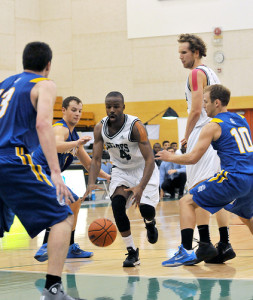The Importance of the Pivot Foot to an On-Ball Screen

When thinking about on-ball screens one aspect which can be glossed over is the ball handlers Pivot Foot. The pivot foot plays a very significant part in the development of different opportunities involving an on-ball screen. Choosing to adopt one philosophy over another in regards to what foot is to be pivoted on, will have different benefits. Having a team that can interchange which foot to pivot on will help in adapting to defensive play and exposing weaknesses within an opposition.
Many coaches when starting out will usually develop a philosophy around which foot is to be pivoted on when using an on-ball screen. This is often glazed over and automatically adopted from one coach to another as a standard teaching point. However, changing the pivot foot when using an on-ball screen brings a greater range and variety to a team’s style of play.

The default technique commonly implemented is for the pivot foot to be to opposite where the screen is set. For example if setting an on-ball screen from the middle of the floor at a wing position. The ball handler would be expected to pivot on their low side foot (the foot closest to the baseline). This helps to facilitate an explosive push off the back leg and perform a stronger drive over the screen and towards the middle of the floor.
As a negative thought, this technique then makes the counter move of ripping the ball through and driving towards the baseline a slower and as a consequence less effective. Additionally, a defensive strategy in this situation is to try to push the ball handler high and off the on-ball screen by having the defender guarding the screen lift early so the dribbler cannot move over the hip of the defender and turn the corner into the keyway. The on-ball defender will also try to move over the screen and so overplay the middle of the floor.
What happens if we look at this scenario with the ball handler pivoting on the high side foot?
If the pivot foot for the wing player is on the high side (foot closest to the halfway line) then some interesting tactical options now become more readily available. One advantage is the benefit for the ball handler in driving baseline. The ball defender will have to guard the perimeter player more in front/straight up or risk being split away from their defensive counterpart guarding the screener. The on-ball defender will no longer be able to overplay the high side of the dribbler. This will also see the on-ball defender needing to react more strongly to jab steps towards the baseline or fail to defend the baseline drive.
A weakness to a high side pivot foot is the effect of essentially slowing down the use of the on-ball screen, as the dribbler has to step across their body. This can hamper some limited dribbling players, as this also has the effect of closing the player’s vision partially over their shoulder, as they have to rotate their hips and torso more to create the necessary effective screening angle.
Being able to use either foot as the pivot provides a more flexible on-ball screen offense. Similar to teaching a range of options for guarding an on-ball screen, using the screen effectively from a high or low pivot foot makes a team that much more effective against a range of opposition tactics. Changing the pivot foot when playing against teams just makes defending that more challenging and allows and offense to use an on-ball screen by either going over or under through different reads.





